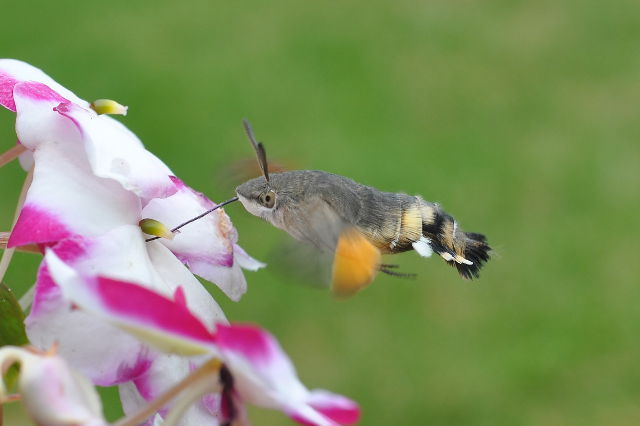Katie from Butterfly Conservation shares this latest news. Ed
Wildlife lovers are being asked to check their gardens for humming-birds in a bid to find out if one of the world’s most striking moths is attempting to colonise the UK.
The unmistakeable Humming-bird Hawk-moth, which is found on the Continent, beats its wings 80 times every second, which allows it to hover with humming-bird like precision over flower heads.
Typically only a summer visitor to the UK, in recent years the warming climate has seen the day-flying moth successfully over-winter in greenhouses and sheltered locations in South West England.
Will it be a hummer summer?
There have been large influxes of the moth in 2000, 2006 and 2011 and hopes are high that 2016 could witness another ‘hummer summer’ as the long distance migrant attempts to gain a foothold in the UK.
Spotting a Humming-bird Hawk-moth has long been considered a good omen – a small swarm of the orange and brown moths was famously seen flying over the Channel on D Day in 1944.
As part of this year’s Moth Night celebrations organisers Butterfly Conservation and Atropos are asking the public to look out for the Humming-bird Hawk-moth in order to build a clearer picture of its UK distribution.
Not just hummers
Other hawk-moths to spot include the spectacular Elephant Hawk-moth, a salmon-pink and olive-green beauty common in gardens across the UK.
Unlike many other moth species, the Elephant Hawk-moth, named for its caterpillar’s trunk-like snout, has seen an increase in its UK distribution in recent years.
The Pine Hawk-moth is another species that has thrived and spread northward in recent years as it has benefited from the increase in conifer plantations.
Some hawk-moths are skilful mimics. Both the Broad-bordered and Narrow-bordered Bee-Hawks deliberately resemble bumblebees but can be told apart by their longer antennae, greater agility and quieter hum.
Focus of Moth Night
Butterfly Conservation Head of Recording, Richard Fox said:
“This year, Moth Night is focussing on Hawk-moths, some of the largest, fastest and most glamorous moths found in the UK.
“From the bat-like Privet- Hawk-moth with its 12cm wingspan to the spell-binding aerobatics of the Humming-bird Hawk-moth and the punk-pink of the Small Elephant Hawk-moth, these moths have the wow factor.
“Attend a Moth Night public event to meet these amazing insects or see if you can track them down on your own patch.”
Get out in the garden and look for moths
Mark Tunmore, editor of Atropos, said:
“June is a particularly colourful time of year for moths with some of our most colourful and spectacular species on the wing and high levels of diversity. It’s a great time to get out into the garden and see what is flying at night or by day.
“In recent weeks there has been a huge influx of the tiny but distinctive Diamond-back Moth Plutella xylostella into the British Isles, which has flown in from the continent and is being seen as far as the Northern Isles.
“This moth can be disturbed easily by day from long grass or attracted to light and could be seen anywhere over the Moth Night period.”
Moth Night 2016
Moth Night 2016 runs from 9 – 11 June and will include moth trapping events across the UK.
Image: © Bob Eade





